 Toyota Yaris: Tire information
Toyota Yaris: Tire information
—Tire symbols (Standard tire)
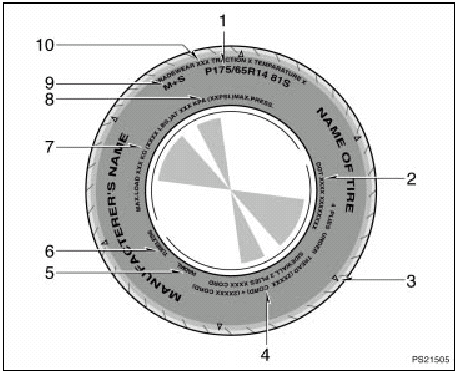
This illustration indicates typical tire symbols.
1. Tire size—For details, see “Tire size”.
2. DOT and Tire Identification Number (TIN)—For details, see “DOT and Tire Identification Number (TIN)”.
3. Location of tread wear indicators —For details, see “Checking and replacing tires”.
4. Tire ply composition and materials —Plies mean a layer of rubber- coated parallel cords. Cords mean the strands forming the plies in the tire.
5. Radial tires or bias-ply tires—A radial tire has “RADIAL” on the sidewall. A tire not marked with “RADIAL” is a bias-ply tire.
6. “TUBELESS” or “TUBE TYPE”—A tubeless tire does not have a tube inside the tire and air is directly filled in the tire. A tube type tire has a tube inside the tire and the tube maintains the air pressure.
7. Load limit at maximum cold tire inflation pressure—For details, see “Checking and replacing tires”.
8. Maximum cold tire inflation pressure—This means the pressure to which a tire may be inflated.
For recommended cold tire inflation pressure, see “Tires”.
9. Summer tire or all season tire—An all season tire has “M+S” on the sidewall. The tire not marked with “M+S” is a summer tire. For details, see “Types of tires”.
10.Uniform tire quality grading— For details, see “Uniform tire quality grading” that follows.
—Tire symbols (Compact spare tire)
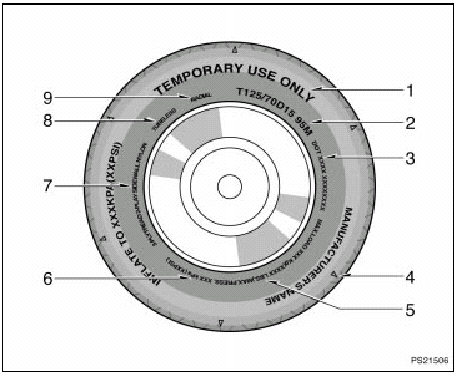
This illustration indicates typical tire symbols.
1. “TEMPORARY USE ONLY”—A compact spare tire is identified by the phrase “TEMPORARY USE ONLY” molded into its sidewall.
This tire is designed for temporary emergency use only. For details, see “Compact spare tire”.
2. Tire size—For details, see “Tire size”.
3. DOT and Tire Identification Number (TIN)—For details, see “DOT and Tire Identification Number (TIN)”.
4. Location of tread wear indicators —For details, see “Checking and replacing tires”.
5. Load limit at maximum cold tire inflation pressure—For details, see “Checking and replacing tires”.
6. Maximum cold tire inflation pressure—This means the pressure to which a tire may be inflated.
For recommended cold tire inflation pressure, see “Tires”.
7. Tire ply composition and materials —Plies mean a layer of rubber- coated parallel cords. Cords mean the strands forming the plies in the tire.
8. “TUBELESS” or “TUBE TYPE”—A tubeless tire does not have a tube inside the tire and air is directly filled in the tire. A tube type tire has a tube inside the tire and the tube maintains the air pressure.
9. Radial tires or bias-ply tires—A radial tire has “RADIAL” on the sidewall. A tire not marked with “RADIAL” is a bias-ply tire.
—DOT and Tire Identification Number (TIN)
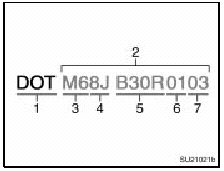
This illustration indicates typical DOT and Tire Identification Number (TIN).
1. “DOT” symbol.
2. Tire Identification Number (TIN).
3. Tire manufacturer ’s identification mark.
4. Tire size code.
5. Manufacturer ’s optional tire type code (3 or 4 letters).
6. Manufacturing week.
7. Manufacturing year
The “DOT” symbol certifies that the tire conforms to applicable Federal Motor Vehicle Safety Standards.
—Tire size
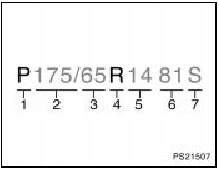
This illustration indicates typical tire size.
1. Tire use (P=Passenger car, T=Temporary use).
2. Section width (in millimeters).
3. Aspect ratio (tire height to section width).
4. Tire construction code (R=Radial, D=Diagonal).
5. Wheel diameter (in inches).
6. Load index (2 digits or 3 digits).
7. Speed symbol (alphabet with one letter).
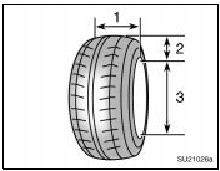
1. Section width.
2. Tire height.
3. Wheel diameter.
—Name of each section of tire
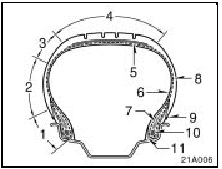
1. Bead.
2. Sidewall.
3. Shoulder.
4. Tread.
5. Belt.
6. Inner liner.
7. Reinforcing rubber.
8. Carcass.
9. Rim lines.
10.Bead wires.
11.Chafer.
—Uniform tire quality grading
This information has been prepared in accordance with regulations issued by the National Highway Traffic Safety Administration of the U.S. Department of Transportation. It provides the purchasers and/or prospective purchasers of Toyota vehicles with information on uniform tire quality grading.
Your Toyota dealer will help answer any questions you may have as you read this information.
DOT quality grades—All passenger vehicle tires must conform to Federal Safety Requirements in addition to these grades. Quality grades can be found where applicable on the tire sidewall between tread shoulder and maximum section width. For example: Treadwear 200 Traction AA Temperature A.
Tread wear—The tread wear grade is a comparative rating based on the wear rate of the tire when tested under controlled conditions on a specified government test course. For example, a tire graded 150 would wear one and a half (1-1/2) times as well on the government course as a tire graded 100. The relative performance of tires depends upon the actual conditions of their use, however, and may depart significantly from the norm due to variations in driving habits, service practices and differences in road characteristics and climate.
Traction AA, A, B, C—The traction grades, from highest to lowest, are AA, A, B, and C, and they represent the tire’s ability to stop on wet pavement as measured under controlled conditions on specified government test surfaces of asphalt and concrete.
A tire marked C may have poor traction performance.
Warning: The traction grade assigned to this tire is based on braking (straight ahead) traction tests and does not include cornering (turning) traction.
Temperature A, B, C—The temperature grades are A (the highest), B, and C, representing the tire’s resistance to the generation of heat and its ability to dissipate heat when tested under controlled conditions on a specified indoor laboratory test wheel. Sustained high temperature can cause the material of the tire to degenerate and reduce tire life, and excessive temperature can lead to sudden tire failure. The grade C corresponds to a level of performance which all passenger car tires must meet under the Federal Motor Vehicle Safety Standard No. 109. Grades B and A represent higher levels of performance on the laboratory test wheel than the minimum required by law.
Warning: The temperature grades for this tire are established for a tire that is properly inflated and not overloaded.
Excessive speed, underinflation, or excessive loading, either separately or in combination, can cause heat buildup and possible tire failure.
—Glossary of tire terminology
| Tire related term | Meaning |
| Cold tire inflation pressure | tire inflation pressure when the vehicle has been parked for at least 3 hours or more, or it has not been driven more than 1.5 km or 1 mile under that condition |
| Maximum inflation pressure | the maximum cold inflation pressure to which a tire may be inflated and it is shown on the sidewall of the tire |
| Recommended inflation pressure | cold tire inflation pressure recommended by a manufacturer |
| Accessory weight | the combined weight (in excess of those standard items which may be replaced) of automatic transmission, power steering, power brakes, power windows, power seats, radio, and heater, to the extent that these items are available as factory-installed equipment (whether installed or not) |
| Curb weight | the weight of a motor vehicle with standard equipment including the maximum capacity of fuel, oil, and coolant, and, if so equipped, air conditioning and additional weight optional engine |
| Maximum loaded vehicle weight | the sum of—. (a) curb weight; (b) accessory weight; (c) vehicle capacity weight; and (d) production options weight |
| Normal occupant weight | 68 kg (150 lb.) times the number of occupants specified in the second column of Table 1 that follows |
| Production options weight | the combined weight of those installed regular production options weighing over 2.3 kg (5 lb.) in excess of those standard items which they replace, not previously considered in curb weight or accessory weight, including heavy duty brakes, ride levelers, roof rack, heavy duty battery, and special trim |
| Vehicle capacity weight (Total load capacity) | the rated cargo and luggage load plus 68 kg (150 lb.) times the vehicle’s designated seating capacity |
| Intended outboard sidewall | (A) the sidewall that contains a whitewall, bears white lettering or bears manufacturer, brand, and/or model name molding that is higher or deeper than the same molding on the other sidewall of the tire or tire, (B) the outward facing sidewall of an asymmetrical tire that has a particular side that must always face outward when mounted on a vehicle |
| Occupant distribution | distribution of occupants in a vehicle as specified in the third column of Table 1 that follows |
| Rim | a metal support for a tire or a tire and tube assembly upon which the tire beads are seated |
| Rim diameter (Wheel diameter) | nominal diameter of the bead seat |
| Rim size designation | rim diameter and width |
| Rim type designation | the industry of manufacturer ’s designation for a rim by style or code |
| Rim width | nominal distance between rim flanges |
| Vehicle maximum load on the tire | the load on an individual tire that is determined by distributing to each axle its share of the maximum loaded vehicle weight and dividing by two |
| Vehicle normal load on the tire | the load on an individual tire that is determined by distributing to each axle its share of the curb weight, accessory weight, and normal occupant weight (distributed in accordance with Table 1 that follows) and dividing by two |
| Weather side | the surface area of the rim not covered by the inflated tire |
Table 1–Occupant loading and distribution for vehicle normal load for various designated seating capacities
| Designated seating capacity, Number of occupants | Vehicle normal load, Number of occupants | Occupant distribution in a normally loaded vehicle |
| 2 through 4 | 2 | 2 in front |
| 5 through 10 | 3 | 2 in front, 1 in second seat |
 Suspension and chassis
Suspension and chassis
CAUTION.
Do not modify the suspension/chassis with lift kits, spacers, springs, etc. It
can cause dangerous vehicle handling characteristics, resulting in loss of control.
...
 Vehicle load limits
Vehicle load limits
Vehicle load limits include total load capacity, seating capacity, towing capacity
and cargo capacity. Follow the load limits shown below. Total load capacity and
seating capacity are also describ ...
See also:
Quarter panel (CUT): Hatchback 5 Door
REPLACEMENT
REMOVAL
INSTALLATION
Temporarily install the new parts and measure each part of the new parts in accordance
with the body dimension diagram. (See the body dimension diagram) Ins ...
Precautions for repairing body structure panels
1. HEAT REPAIR FOR BODY STRUCTURE PANELS
Toyota prohibits the use of the heat repair method on body structure panels when
repairing a vehicle damaged in a collision.
Panels that have high streng ...
Front door outer panel (CUT): Sedan U.S.A., Canada
REPLACEMENT
REMOVAL
INSTALLATION
Temporarily install the new parts and measure each part of the new parts in accordance
with the body dimension diagram. (See the body dimension diagram) Inspe ...
